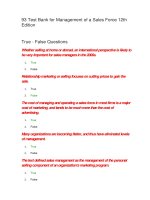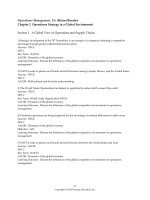Operations management 12th stevenson ch09 management of quality
Bạn đang xem bản rút gọn của tài liệu. Xem và tải ngay bản đầy đủ của tài liệu tại đây (862.12 KB, 40 trang )
Chapter 9
Management of
Quality
McGraw-Hill/Irwin
Copyright © 2012 by The McGraw-Hill Companies, Inc. All rights reserved.
Chapter 9: Learning Objectives
You should be able to:
1. Define the term quality as it relates to products and
as it relates to services
2. Explain why quality is important and the
consequences of poor quality
3. Identify the determinants of quality
4. Distinguish the costs associated with quality
5. Compare the quality awards
6. Discuss the philosophies of quality gurus
7. Describe TQM
8. Give an overview of problem solving
9. Give an overview of process improvement
10. Describe and use various quality tools
Instructor Slides
9-2
Quality Management
Quality
The ability of a product or service to consistently
meet or exceed customer expectations
For a decade or so, quality was an important focal point in
business. After a while, this emphasis began to fade as
other concerns took precedence
There has been a recent resurgence in attention to quality
given recent experiences with the costs and adverse
attention associated with highly visible quality failures:
Auto recalls
Toys
Produce
Dog food
Pharmaceuticals
Instructor Slides
9-3
Dimensions of Product Quality
Performance– main characteristics of the product
Aesthetics– appearance, feel, smell, taste
Special features– extra characteristics
Conformance– how well the product conforms to design
specifications
Reliability– consistency of performance
Durability– the useful life of the product
Perceived quality– indirect evaluation of quality
Servicebility– handling of complaints or repairs
Instructor Slides
9-4
Dimensions of Service Quality
Convenience– the availability and accessibility of the service
Reliability– ability to perform a service dependably, consistently,
and accurately
Responsiveness– willingness to help customers in unusual
situations and to deal with problems
Time– the speed with which the service is delivered
Assurance– knowledge exhibited by personnel and their ability
to convey trust and confidence
Courtesy– the way customers are treated by employees
Tangibles– the physical appearance of facilities, equipment,
personnel, and communication materials
Consistency– the ability to provide the same level of good
quality repeatedly
Instructor Slides
9-5
Assessing Service Quality
Audit service to identify strengths and
weaknesses
In particular, look for discrepancies
between:
Customer expectations and management perception of
those expectations
2. Management perceptions customer expectations and
service-quality specifications
3. Service quality and service actually delivered
4. Customers’ expectations of the service provider and
their perceptions of provider delivery
1.
Instructor Slides
9-6
Determinants of Quality
Quality of design
Intention of designers to include or exclude features in a product
or service
Quality of conformance
The degree to which goods or services conform to the intent of
the designers
Ease-of-Use and user instructions
Increase the likelihood that a product will be used for its intended
purpose and in such a way that it will continue to function
properly and safely
After-the-sale service
Taking care of issues and problems that arise after the sale
Instructor Slides
9-7
Responsibility for Quality
Everyone in the
organization has some
responsibility for
quality, but certain
areas of the
organization are
involved in activities
that make them key
areas of responsibility.
Instructor Slides
Top management
Design
Procurement
Production/operations
Quality assurance
Packaging and
shipping
Marketing and sales
Customer service
9-8
Benefits of Good Quality
Enhanced reputation for quality
Ability to command premium prices
Increased market share
Greater customer loyalty
Lower liability costs
Fewer production or service problems
Lower production costs
Higher profits
Instructor Slides
9-9
The Consequences of Poor Quality
Loss of business
Liability
Productivity
Costs
Instructor Slides
9-10
Costs of Quality
Appraisal Costs
Costs
of activities designed to ensure quality or
uncover defects
Prevention Costs
All
TQ training, TQ planning, customer
assessment, process control, and quality
improvement costs to prevent defects from
occurring
Instructor Slides
9-11
Costs of Quality
Failure Costs - costs incurred by
defective parts/products or faulty
services.
Internal Failure Costs
Costs incurred to fix problems that are detected
before the product/service is delivered to the
customer.
External Failure Costs
All costs incurred to fix problems that are detected
after the product/service is delivered to the
customer
Instructor Slides
9-12
Ethics and Quality
Substandard work
Defective products
Substandard service
Poor designs
Shoddy workmanship
Substandard parts and materials
Having knowledge of this and failing to correct
and report it in a timely manner is unethical.
Instructor Slides
9-13
Quality Contributors
Contributo
r
Key Contributions
Shewart
Control charts; variance reduction
Deming
14 points; special vs. common causes of
variation
Juran
Quality is fitness-for-use; quality trilogy
Feigenbaum
Quality is a total field; the customer defines
quality
Crosby
Quality is free; zero defects
Ishikawa
Cause-and-effect diagrams; quality circles
Taguchi
Taguchi loss function
Ohno and
Shingo
Continuous improvement
Instructor Slides
9-14
Deming’s 14 Points
Deming’s 14 Points
1. Create constancy of purpose toward improvement of product and service with
a plan to become competitive and stay in business.
2. Adopt the new philosophy. We are in a new economic age. We can no longer
live with commonly accepted levels of delays, mistakes, defective materials,
and defective workmanship
3. Cease dependence on mass inspection.
4. End the practice of awarding on the basis of price tag.
5. Find problems. It is management’s job to work continually on the system.
6. Institute modern methods of training on the job
7. The responsibility of foremen must be changed from sheer numbers to
quality.
8. Drive out fear, so that everyone may work effectively for the company.
9. Break down barriers between departments.
10. Eliminate numerical goals, posters, and slogans for the workforce asking for
new levels of productivity without providing methods.
11. Eliminate work standards that prescribe numerical quotas.
12. Remove barriers that stand between the hourly worker and his right to pride
of workmanship.
13. Institute a vigorous program of education and retraining.
14. Create a structure in top management that will push every day on the above
13 points.
Instructor Slides
9-15
Quality Awards and Certification
Quality Awards
Deming Prize
Malcolm Baldrige National Quality Award
European Quality Award
Quality Certifications
ISO 9000
ISO 14000
ISO 24700
Instructor Slides
9-16
The Baldrige Competition
Benefits of the Baldrige Competition
1.
2.
3.
4.
5.
Winners achieve financial success
Winners share their knowledge
The process motivates employees
The process requires obtaining data
The process provides feedback
Instructor Slides
9-17
The Baldrige Competition
Award Categories
1.
2.
3.
4.
5.
6.
Education
Healthcare
Manufacturing
Nonprofit/Government
Service
Small Business
Instructor Slides
9-18
Baldrige Criteria
Instructor Slides
9-19
Quality Certification
International Organization for Standardizati
on
ISO 9000
Set of international standards on quality management
and quality assurance, critical to international business
ISO 14000
A set of international standards for assessing a
company’s environmental performance
ISO 24700
Pertains to the quality and performance of office
equipment that contains reused components
Instructor Slides
9-20
Quality Certification
ISO 9000: 2005
Quality Principles:
Principle 1 Customer focus
Principle 2 Leadership
Principle 3 Involvement of people
Principle 4 Process approach
Principle 5 System approach to management
Principle 6 Continual improvement
Principle 7 Factual approach to decision making
Principle 8 Mutually beneficial supplier relationships
Instructor Slides
9-21
Quality and the Supply Chain
Business leaders are increasingly recognizing
the importance of their supply chains in
achieving their quality goals
Requires:
Measuring customer perceptions of quality
Identifying problem areas
Correcting these problems
Supply chain quality management can benefit
from a collaborative relationship with suppliers
Helping suppliers with quality assurance efforts
Information sharing on quality-related matters
Instructor Slides
9-22
Total Quality Management
A philosophy that involves everyone in an
organization in a continual effort to improve
quality and achieve customer satisfaction.
T
Instructor Slides
Q
M
9-23
TQM Approach
1. Find out what the customer wants
2. Design a product or service that meets or
exceeds customer wants
3. Design processes that facilitate doing the job
right the first time
4. Keep track of results
5. Extend these concepts throughout the supply
chain
Instructor Slides
9-24
TQM Elements
Continuous improvement
2. Competitive benchmarking
3. Employee empowerment
1.
4.
5.
6.
7.
8.
Team approach
Decision based on fact, not opinion
Knowledge of tools
Supplier quality
Champion
Quality at the source
10. Suppliers are partners in the process
9.
Instructor Slides
9-25









